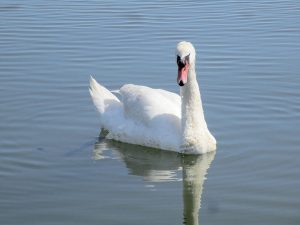Naturalists Warn That Mute Swans Are Elegant Disrupters
By Joseph Sapia
EARLIER THIS MONTH on the Shrewsbury River at Monmouth Beach, two large white swans, along with their two cygnets, casually approached two boats.
“Somebody must be feeding them,” said someone on the boat.
In the outdoors world, that may be one of the tamer comments made about “mute swans” – the swans seen this time of year, and year-round, on fresh or brackish local water ways and bodies of water.
A serious birdwatcher may call them “harbor hogs” or “pond pigs,” reflecting the “dislike” birders have for them, said Pete Bacinski, an Atlantic Highlands resident who is a member of the state Waterfowl Advisory Committee and the retired director of New Jersey Audubon’s Sandy Hook Bird Observatory.
Hoggish and piggish, not because they might want to mooch some food from friendly humans – a lot of animals do that. But because they are a non-native, invasive species that disrupts the natural world around them.
“They pretty much take over, they’re the boss of the pond,” said Skinner, who is based at Huber Woods Park in Middletown. “They deplete the vegetation. They discourage other waterfowl – (and) not just water fowl.
“And they attack humans,” Skinner said. “Give you a mean little bite, whack you with their wings.”
“They are nasty to people,” Bacinski said. “They could literally take a finger off. Their beauty is the only good.”
“Mute swans are a very polarizing issue,” said Dena Temple, public relations chair for the Monmouth County Audubon Society. “People think they are beautiful – and they are. However, they are a non-native species. And just as non-native plants disrupt the balance of the environment, so do non-native birds and other animals.”
And All About Birds notes the negative, “Their aggressive behavior and voracious appetites often disturb local ecosystems, displace native species and even pose a hazard to humans.”
New Jersey has two native swans – tundras and trumpeters, which are winter species in New Jersey. In the Two River area, they are basically migrants, Bacinski said.

“In the case of the mute swans, when a mute swan moves into an area pond, it’s a case of ‘there goes the neighborhood,’” Temple said.
“Being a very large bird, they eat a lot and can decimate the aquatic vegetation in a pond, leaving little food for other birds,” said Temple. “They also disengage more plant material than they actu- ally consume, leaving the aquatic habitat destroyed for fish and invertebrates that breed in the cover of the aquatic vegetation.”
They live long, perhaps 19 or 20 years and their cygnets – mostly two, sometime three – have a “75 to 80 percent survival rate because their parents are so protective,” Skinner said. So, when they are around, they are around to stay.
The Atlantic Flyway, the coastal migration route of North America, had an estimated 9,000 birds five years ago, according to the Atlantic Flyway Mute Swan Management Plan, an American-Canadian report released in July 2015.
The Management Plan calls for such things as educating the public on mute swans, reducing the population to less than 2,000 by 2025, maintaining mute swans at an ecologically manageable level, preventing the expansion of their range and getting stakeholders involved in the process.
“There is a large movement around the country to curb the population growth,” Skinner said. “Like any argument, there’s two sides.”
A few years ago, New York State proposed gathering its population of mute swans and killing them – but it got push-back and it never came to fruition. Now, non-lethal methods are planned to reduce the population, such as preventing eggs from hatching.
“Mute swans have a long lifespan and a tremendous reproductive capacity,” says Temple. “What do you do with the swans? Relocating them will only compound the problem by introducing them into areas where they didn’t exist before. Killing eggs has been shown to be ineffective in reducing the population because of the birds’ reproductive capacity.”
“I don’t like to see a slaughter,” Bacinski said. “Most states will shoot them when they show up if they have not been established there.”
Bacinski’s feelings on mute swans?
“They’re dreadful,” Bacinski said. “When I see them, I sort of ignore them.”














